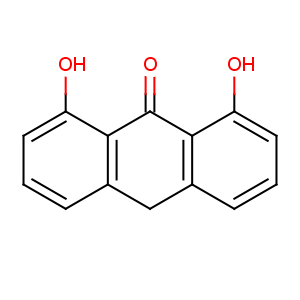Title: Anthralin
CAS Registry Number: 1143-38-0
CAS Name: 1,8-Dihydroxy-9(10
H)-anthracenone
Synonyms: 1,8-dihydroxyanthrone; dithranol
Trademarks: Anthraforte (Stiefel); Anthranol (Stiefel); Anthrascalp (Stiefel); Antraderm (Protea); Cignolin (Bayer); Dithrocream (Dermal); Drithocreme (Dermik); Dritho-Scalp (Dermik); Micanol (Bioglan); Psoradrate (Procter & Gamble); Psoriderm (Istoria)
Molecular Formula: C14H10O3
Molecular Weight: 226.23
Percent Composition: C 74.33%, H 4.46%, O 21.22%
Literature References: Prepn: Y. Hirosé,
Ber. 45, 2474 (1912); K. Zahn, H. Koch,
ibid. 71B, 172 (1938). Revised structure: H. M. Avdovich, G. A. Neville,
Can. J. Spectrosc. 25, 110 (1980); F. R. Ahmed,
Acta Crystallogr. B36, 3184 (1980). Historical review: R. E. Ashton
et al., J. Am. Acad. Dermatol. 9, 173-192 (1983). Review of mechanism of action: L. Kemény
et al., Skin Pharmacol. 3, 1-20 (1990); of clinical pharmacology and efficacy in psoriasis: G. Mahrle,
Clin. Dermatol. 15, 723-737 (1997).
Properties: Lemon yellow leaflets or needles from ligroin, mp 176-181°. Practically insol in water. Sol in chloroform, acetone, benzene. Slightly sol in alcohol, ether, glacial acetic acid. Sol in dil NaOH with yellow color and green fluorescence, becoming orange-red on exposure to air.
Melting point: mp 176-181°
Therap-Cat: Antipsoriatic.
Keywords: Antipsoriatic.

